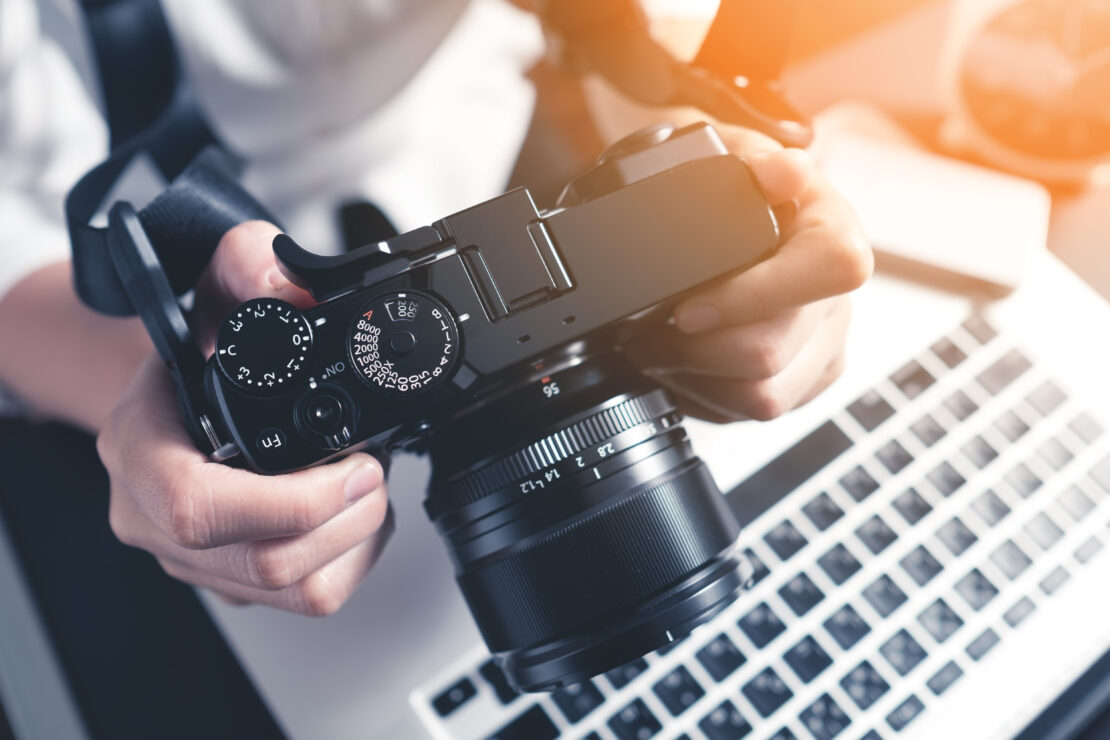A Client’s Guide to Taking Item Photographs
Republished in abridged format from the original article in Worthwhile Magazine™, which can be read in full here: A Client’s Guide For How to Take Photographs of Art and Antiques to Send to An Appraiser By Elizabeth Stewart, PhD, AAA and John Flandrick
“The following guide is designed to help an appraiser’s clients take photographs of their items to be appraised that will be most helpful in conveying the specific connoisseurship details an appraiser needs to evaluate an item. It is one thing to say “send me pictures” and quite another thing for a new client to know what we need to see.“
Sarah Reeder, ISA CAPP, Co-Editor of Worthwhile Magazine™ and Owner of Artifactual History® Appraisal.
1. FINE ART:
A. How to photograph so an expert can see:
- Photograph the entire piece with frame
- Close up of “sight image” (just the image, not the frame)
- Close up of signature and angled shot of signature
- Shot of back with any markings
- Shot of you measuring the piece
- Image size only
- Size of entire piece including the frame
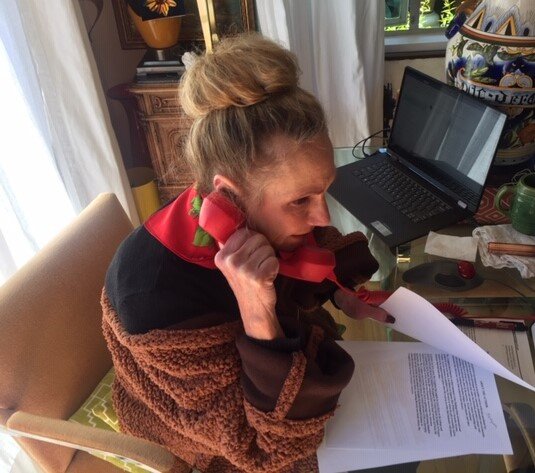
B. Characteristics; make notes on:
- Artist
- Date of creation
- Where “shown,” previously exhibited, or owned (provenance)
- Condition – front and back
- Condition lighting: shine a flashlight to the angle of the side of an oil painting to show the raised brush strokes
- Size (from the measuring described above)
- Genre (what style) especially if unsigned
- Multiple:
- If a lithograph, etching, engraving, silkscreen, serigraph, note “fraction” (edition number, for example 37/225)
- If a print of any type, including a photo-mechanical reproduction (better known as a poster) note if the work is signed “in the plate” meaning if the reproduction includesthe signature, or if it is signed with an original or perhaps double (both in the plate and on the piece by hand) signature.


Photographs by John Flandrick, Flandricka House Photography
2. SILVER:
A. How to photograph so an expert can see:
- Silver reflects, so shoot with dark background
- Shoot close ups of hallmarks or any markings
- Shoot around areas where there may have been repairs (spouts, handles)
- Shoot any other material (glass, ivory, bone, wood) and how it is attached
- Be aware of color changes which may not come out in photos – gold is often applied to silver (vermeil)
B. Characteristics; make notes on:
- Hallmark
- Note if marked EPNS or “silver soldered;” this is not sterling
- Sterling or silverplate? Note the thickness of hollowware. Silverplate is often thicker and heavier than sterling
- Age
- Style (for example, Nouveau is valuable, Rococo Revival less so)
- Famous makers (such as Tiffany) or retailed from a famous shop (for example Liberty or Cartier)
- Weight in troy ounces (this is different from regular ounces. If you don’t have a troy ounce scale, measure in ounces but be sure to let the appraiser know so the conversion can be made)

3. GLASS DECORATIVE ITEMS AND TABLEWARE/BARWARE:
A. How to photograph so an expert can see:
- Cut glass versus pressed – hard to see in photos. Check sharpness of the “dentils:” the cuts, which are “sharp” in cut glass; use close up feature on camera
- Measurements, including diameter
- Shoot in great outdoor light
- Set closeup of the hallmark (which is often hard to find as they are not always on the bottom)
- Blown or machine made? (The three categories are blown, blown in a mold, and machine made.) Shoot a close up of bottom, there, look for these features:
- Pontil mark, which is where the glass blower would have attached his blow rod. These are sometimes ground down like an inverted saucer.
- Look for a signature; good modern glass is often signed.
- Look for a fraction or number. Fraction means a series (edition), a number may mean a style or model number.
B. Characteristics; make notes on:
- Sizes
- Color (check to see if the colors of the glass seem to be in “layers” (cased glass)
- Purpose – what was it used for? Art piece? Tableware?
- Age
- Maker
- Period/date
- Originality (Tiffany Favrile or Tiffany reproduction)
- Condition; extremely important, but hairline damage is hard to see, especially in photos
- Wear: on glass used often at table, you’ll see wear marks, which you should see if the piece is old and not a reproduction
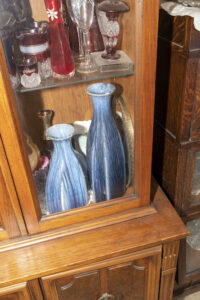
4. PORCELAIN and CERAMICS:
A. How to photograph so an expert can see:
- Shoot dimensions including a measuring tape in the image
- Condition – porcelain that was used at table will have knife marks, etc. Shoot traces of wear with ‘raking’ light, which is a light source like a flashlight held at an angle while shooting
- Repairs – on some old pieces a repair is acceptable and expected (for example Chinese Export porcelain or very old pieces)
- Maker – or hallmark – or number – or signature of factory. Shoot also all undersides, and geometrical markings, numbers, (model, edition, series) and dates
- Shoot closeup of decoration: hand-painted or hand-decorated design will typically not be “deep under” the clear glaze
- Shoot whole set if there’s a set, or shoot a sample and tell the appraiser how many are included in the total set
B. Characteristics; make notes on:
- Set, services
- Color, glaze
- Condition, repairs
- “Foot” – is the bottom rim glazed? Do you see kiln marks?
- Signature, maker
- Style
- Age
- Shape
- Country or culture of origin
- Decoration or enameling or painting or gilding (gold, platinum, silver)
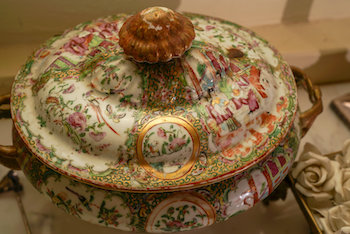
5. FURNITURE:
A. How to photograph so an expert can see:
- The whole piece front, back, bottom
- Special shots of “joins,” dovetails, applied “gingerbread,” backs of drawers where drawer pull holes are evident, hardware, hinges, locks, escutcheons, casters, feet, mullions on glazed doors, bottoms of drawers, one shot where “air” exposure over time has NOT occurred /such as a drawer liner (board between drawer bottom and drawer slot)
- Veneering, graining, a side shot of a veneered surface
- Crawl underneath and shoot up
- Labels, markings, numbers, any pencil marks
- Dimensions – shoot yourself measuring
B. Characteristics; make notes on:
- Age
- Style
- Craftsmanship
- Maker
- Use
- Country and culture of origin
- Rarity
- Added features (a dry bar for example)
- Carving, decoration, additional materials (copper embossed straps for example)
- Feet – wear and originality
- Condition
- Type of wood
- Refinished?
- Provenance
- Paint?
- Dust board on back, undersides
- “Plane” marks, measurement marks, type of glues, hardware, glazing
- Functionality
- Genre or period
- Geographical location
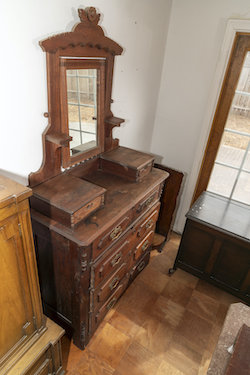
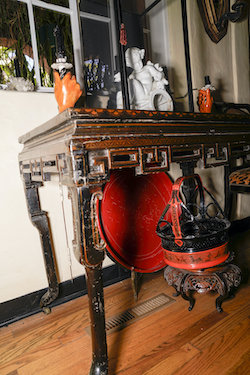
Photograph by John Flandrick, Flandricka House Photography
A PROFESSIONAL PHOTOGRAPHER’S TOP TEN TIPS FOR PHOTOGRAPHING OBJECTS
by John Flandrick of Flandricka House Photography
1. Direct sunlight is not your friend; outdoor daylight in shade lighting is great, diffused light (under a tree) is excellent, or shoot by an open window, or in a garage with the door open
2. Avoid glare on art framed with glass by angling the shot, not straight on, and never shoot art in direct sunlight (bad for art) and bad for shot
3. If client can get a partner to hold a flashlight, shoot oil paintings with raking light: the flashlight held at a 30-degree angle to the painting’s side. And for any photo – when you are tempted to use the phone flash, try another light source first. (Like the flashlight!) You might suggest to your client to pull out a strong flashlight – before you ‘virtually visit’
4. For glass or porcelain, do not use phone flash, use a table lamp with a shade and move it close to the object
5. For furniture, ask the client to shoot when house is lit up (mid-day) but do not shoot pieces in direct bright light
6. Indirect light at noon is best for most objects; ask client when house is the brightest, as this will change as the direction of the sun changes in each season through the year
7. For valuable art, especially oil paintings, shoot outside during the “golden hour” between 4 and 5 pm
8. Tell your clients to shoot everything with a ruler in the shot. For very large pieces, make sure you get “scale:” put a person in the frame (this can be especially important with insurance shots)
9. Get 3 shots of any signature from varying angles
10. Check how to read metadata on telephone shots for date stamps and research now how to take date stamped screen shot photographs as you “Face Time” a client. The technique for taking screen shots varies depending on which device you are using but can be determined by searching for “how to take screen shots on [your device model].” The date stamp is especially helpful because it establishes the exact day and time the image was captured, and documents the item’s condition at that time
Elizabeth Stewart, PhD, AAA is the owner of Elizabeth Appraisals in Santa Barbara, California and a Certified Member of the Appraisers Association of America. You can visit her website at https://elizabethappraisals.com.
John Flandrick is a professional photographer and the owner of Flandricka House Photography. In addition to his work documenting California’s great collections of art and antiques, he also works extensively with members of the publishing and music industries.

